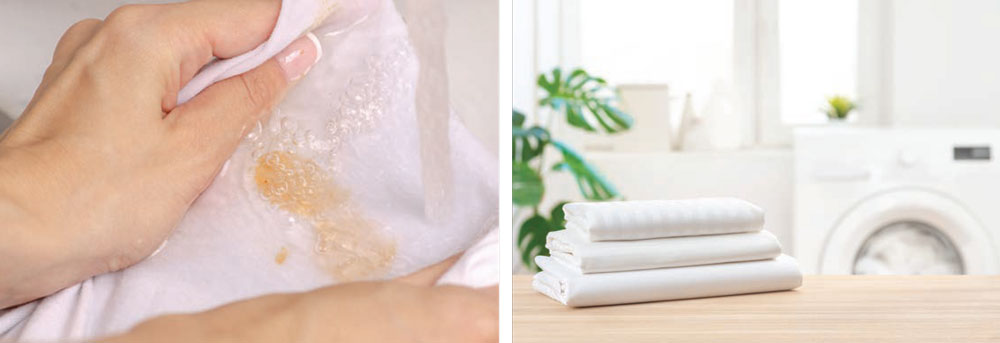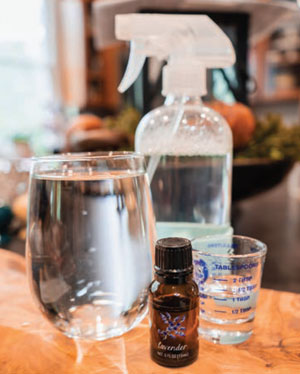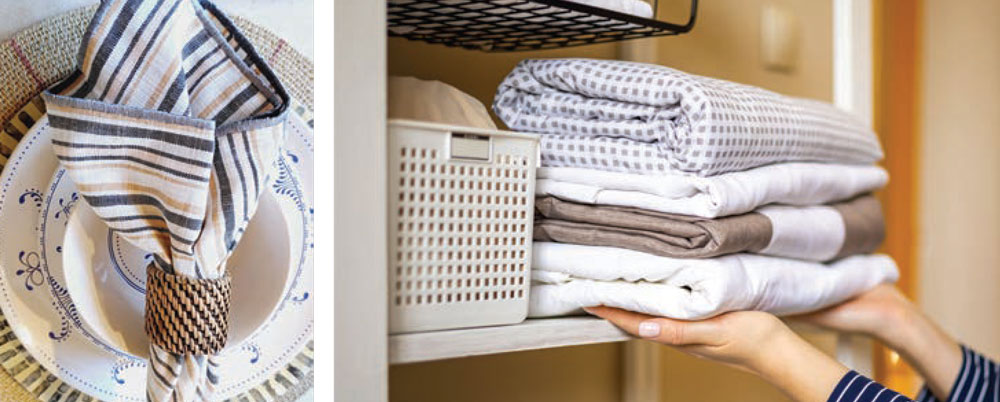CARING FOR TABLE LINENS
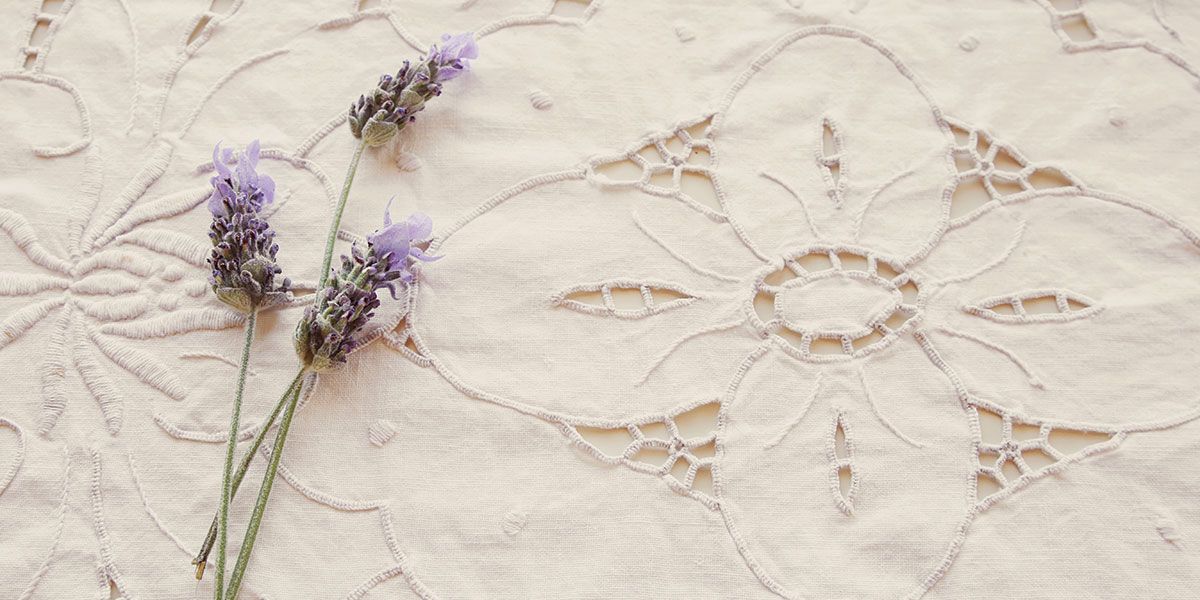
Preserve Their Beauty & Add a Lovely Scent
Nothing spells SPECIAL OCCASION more than setting a table with beautiful linens. Whether yours are heirloom pieces from favorite relatives, treasured gifts from friends and family, linens purchased as souvenirs of long-ago trips or simply items purchased during memorable antiquing jaunts, keeping them in tiptop shape will extend their lives. Read on for some time-tested guidelines for caring for your table linens.
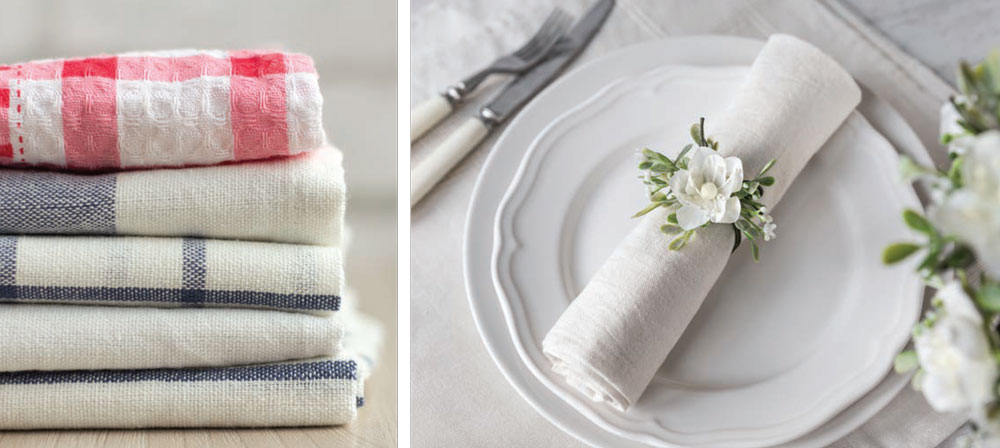 Pretreat stains and wash
Pretreat stains and wash
Experts agree that pretreating any stains and then washing soiled table linens immediately after each use is the critical first step in prolonging their lives. The Spruce, an online source of information about all things home and garden-related, reminds us that some heirloom and embellished linens may benefit from a spot cleaning with a mild laundry detergent and hand washing in cold water. This careful treatment will preserve the color and fiber strength of antique or embellished linens in cases where machine washing would be too rough. Indeed, whatever their fiber contents, all table linens can profit from prompt stain removal and laundering.
In the unfortunate event of an oily food stain on delicate fabrics, begin by dabbing (but not rubbing) a bit of heavy-duty detergent such as Tide or Persil on the stain with your fingers or a soft white cloth. Then let the cleaning solution soak in for at least 15 minutes before rinsing the spot with cool water. If the stain still shows after the first rinse, spot treat with either Resolve or Oxi Clean formulated for fabrics and hand wash the item again. Repeat this process until the stain is gone. For dingy or stained all-white fabrics, a small amount of colorfast oxygen bleach may be used for spot treating and for overall lightening. Adding a drop of bluing liquid may also be used during laundering to restore yellowed linens to brightness.
Machine drying vs. air drying
According to eventswholesale.com, an online purveyor of all kinds of table linens for special occasions, air drying (also referred to as line drying) is the recommended method for drying all kinds of table linens except for those made of 100 percent polyester or cotton-polyester blends. These sturdier fabrics may safely be machine washed and dried at a low heat or on the permanent-press cycle and removed promptly to avoid excessive wrinkling.
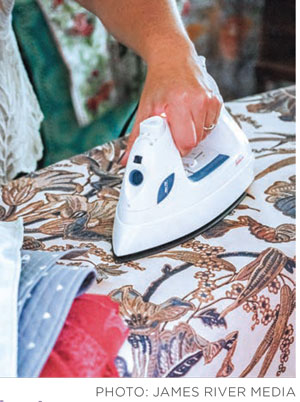 Ironing
Ironing
Many table linens, whether air or machine-dried, require ironing to look their best. If larger pieces of table linens such as tablecloths have been stored after washing without having been pressed, a spritzing with water or, better yet, scented water (see page 37) before ironing will produce better results. Of course, if you plan to iron your linens right after machine washing and drying, removing them from the dryer when still slightly damp will make the job of ironing much easier.
For ironing larger pieces such as tablecloths, set up your padded ironing board at the foot of a bed or large table so that as you iron you can spread the fabric over the bed or table’s surface instead of letting the ironed portion puddle on the floor and wrinkle. Always iron the reverse side of the fabric and the front side only if necessary.
Another option for larger linens is to use a steamer. Steaming is gentle and doesn’t damage the fabric, but may not get out wrinkles as fully as a traditional iron.
- 1 teaspoon essential oil (lavender, rose, rosemary, eucalyptus)
- 1 Tablespoon witch hazel or vodka
- 16 ounces distilled water
Shake together in spray bottle. Refrigerate leftovers.
Photo: James River Media
Cloth napkins that will be folded into rectangles may be stored either flat or folded, whereas those that will be folded into fancy shapes may benefit from a light spray of starch during the ironing process, stored flat and then artfully folded just before using. Note that it is critical that everything freshly ironed be left out for a couple of days to dry fully to prevent mildew.
Storing table linens
Once completely dry, table linens may be stored flat or hung in a cool, dry, well-ventilated area. Use padded hangers, or for larger, heavier pieces such as tablecloths, place them on heavy-duty blanket hangers to prevent creasing. Avoid storing table linens in plastic bags, cardboard boxes or in direct contact with cedar chests or wood drawers. Instead, loosely wrap all but the largest, hung linens in clean white 100 percent cotton sheets or acid-free tissue paper and store them on shelves in closets. With proper care and storage, treasured linens will be passed down through generations, enhancing festive occasions with each use. ✦
air drying, heirloom, ironing, machine drying, pretreating, steaming, storing table linens, table linens
